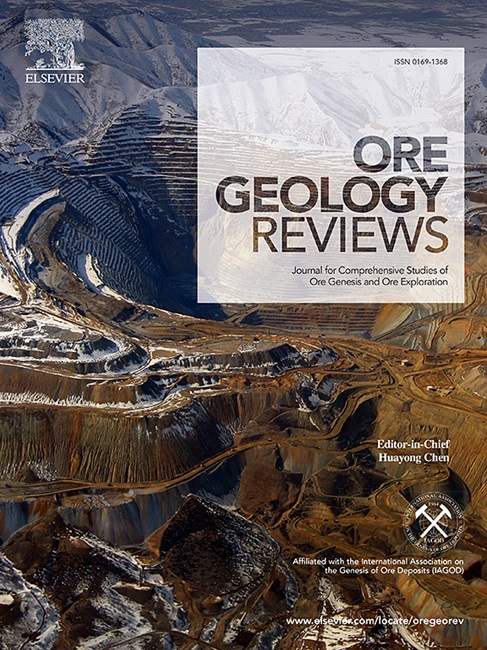Geochronology, geochemistry, and Hf isotopic compositions of the Jintonghu porphyry Cu-Mo deposit in the Zijinshan ore district, SE China: Insights into the controlling factors on magma fertility
IF 3.6
2区 地球科学
Q1 GEOLOGY
引用次数: 0
Abstract
The Jintonghu porphyry Cu-Mo deposit is located in the Zijinshan ore district within the southeastern coastal volcanic belt, China. Copper mineralization is predominantly restricted to the granodiorite porphyry, whereas the other intrusions remain barren. This disparity highlights the need for deeper insights into the controlling factors on magma fertility and its contribution to copper mineralization. There are four intrusive phases at Jintonghu, including the Early Cretaceous pre-mineralization Sifang granodiorite (109.2 ± 0.6 Ma), syn-mineralization diorite porphyry (105.4 ± 0.4 Ma), dacite porphyry (105.5 ± 0.5 Ma), and granodiorite porphyry (105.5 ± 0.5 Ma and 105.6 ± 0.5 Ma), late-mineralization porphyritic granodiorite (103.4 ± 0.6 Ma), and Late Cretaceous post-mineralization quartz syenite porphyry (99.1 ± 1.0 Ma). Zircon Hf isotopic compositions demonstrate that the Early Cretaceous intrusions share a similar source. The granodiorite porphyry and porphyritic granodiorite present higher zircon εHf(t) values (−2.49 to 1.43), suggesting an increasing contribution from the mantle-derived materials or juvenile crust. The estimated oxygen fugacity based on zircon trace elements shows no clear differences among the pre-, syn-, and late-mineralization phases, suggesting that oxygen fugacity is not the first-order factor controlling magma fertility at Jintonghu. Instead, the granodiorite porphyry and porphyritic granodiorite are inferred to be more hydrous, as evidenced by distinctly elevated zircon Eu/Eu* (0.42–0.91), 10,000 × (Eu/Eu*)/Y (4.61–17.5), and (Ce/Nd)/Y (0.01–0.19) ratios, along with low zircon Dy/Yb (0.11–0.17) ratios and amphibole-dominated fractionation. Therefore, high magmatic water content is the dominant factor controlling magma fertility in the Jintonghu deposit. Furthermore, the porphyritic granodiorite shares coincident geochemical proxies with those of the ore-hosting granodiorite porphyry, combined with their comparable alteration patterns, indicating its copper mineralization potential.

紫金山矿区金通湖斑岩型铜钼矿床的年代学、地球化学及Hf同位素组成:岩浆富力控制因素的认识
金通湖斑岩型铜钼矿床位于中国东南沿海火山带紫金山矿区。铜的成矿作用主要局限于花岗闪长斑岩,而其他侵入体则保持贫瘠。这一差异突出表明,有必要深入了解岩浆富力的控制因素及其对铜成矿作用的贡献。金通湖侵入期主要有早白垩世成矿前四方花岗闪长岩(109.2±0.6 Ma)、同成矿闪长斑岩(105.4±0.4 Ma)、英安岩斑岩(105.5±0.5 Ma)、花岗闪长斑岩(105.5±0.5 Ma和105.6±0.5 Ma)、晚成矿斑岩花岗闪长岩(103.4±0.6 Ma)和晚白垩世成矿后石英正长斑岩(99.1±1.0 Ma) 4期。锆石Hf同位素组成表明,早白垩世侵入岩具有相似的来源。花岗闪长斑岩和花岗闪长斑岩的锆石εHf(t)值较高(- 2.49 ~ 1.43),表明地幔源物质或幼壳的贡献增加。根据锆石微量元素估算的氧逸度在成矿前、成矿前后和成矿后期没有明显差异,表明氧逸度不是控制金通湖岩浆富集度的一级因素。锆石Eu/Eu*(0.42 ~ 0.91)、10000 × (Eu/Eu*)/Y(4.61 ~ 17.5)和(Ce/Nd)/Y(0.01 ~ 0.19)比值明显升高,锆石Dy/Yb(0.11 ~ 0.17)比值较低,角闪石分选作用明显,表明花岗闪长斑岩和斑状花岗闪长岩含水较多。因此,高岩浆含水量是控制金通湖矿床岩浆富力的主导因素。斑岩花岗闪长岩地球化学指标与含矿花岗闪长斑岩地球化学指标一致,蚀变模式相似,表明其铜成矿潜力。
本文章由计算机程序翻译,如有差异,请以英文原文为准。
求助全文
约1分钟内获得全文
求助全文
来源期刊

Ore Geology Reviews
地学-地质学
CiteScore
6.50
自引率
27.30%
发文量
546
审稿时长
22.9 weeks
期刊介绍:
Ore Geology Reviews aims to familiarize all earth scientists with recent advances in a number of interconnected disciplines related to the study of, and search for, ore deposits. The reviews range from brief to longer contributions, but the journal preferentially publishes manuscripts that fill the niche between the commonly shorter journal articles and the comprehensive book coverages, and thus has a special appeal to many authors and readers.
 求助内容:
求助内容: 应助结果提醒方式:
应助结果提醒方式:


